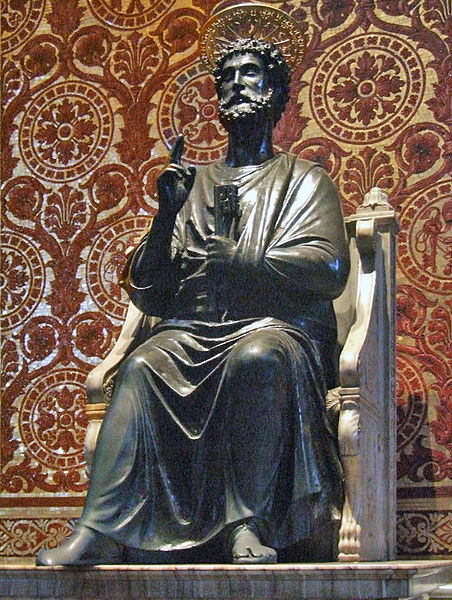Lazio : Saint Peter Enthroned
The statue of Saint Peter Enthroned was a crucial figure in Rome at, directly before, and after the time of the plague because of the role it played in pilgrimage and the way that it lent itself to the very identity of Rome at the time. The statue of Saint Peter was most likely made by Arnolfo di Cambio in the year 1300. In modern times, the statue is located in a small chapel which is to the left of the apse in St. Peter’s Basilica in Rome. The statue rises up behind the altar of the chapel. It is said to be based on an antique statue of a philosopher and in the past it stood in the Atrium of Old St. Peter’s. There used to be a great deal of debate over the dating of the statue. The date was positively attributed to being most likely the year 1300, when Bruno Bearzi analyzed and dated the bronze alloy in 1957. There is little to no information to be found on the commission of the piece. However, one can assume that it had something to do with the Jubilee year in Rome that was going on at the same time.
The piece is attributed to the artist Arnolfo di Cambio, primarily because of the style of the piece. Arnolfo di Cambio was a sculptor and architect who worked in Rome and Florence. He lived from 1265 to 1302 and he was a student of the renowned Nicola Pisano. It was in the year 1300, when this statue was believed to have been created, that an event occurred to drastically change the role of Rome at the time. On February 22, 1300 Pope Boniface VIII declared a holy year and a Jubilee in Rome that would be repeated every set number of years. Pope Boniface offered pilgrims a plenary indulgence in the Jubilee year. An indulgence was something that the church would grant to an individual which would give them forgiveness for a specific sin and therefore allow them to spend less time in purgatory. A plenary indulgence would offer forgiveness to the pilgrim for the sins that they committed over the span of their whole life. The statue of Saint Peter Enthroned was created in Rome within that time period of the Jubilee, therefore putting it at the heart of Rome’s pilgrimage.

